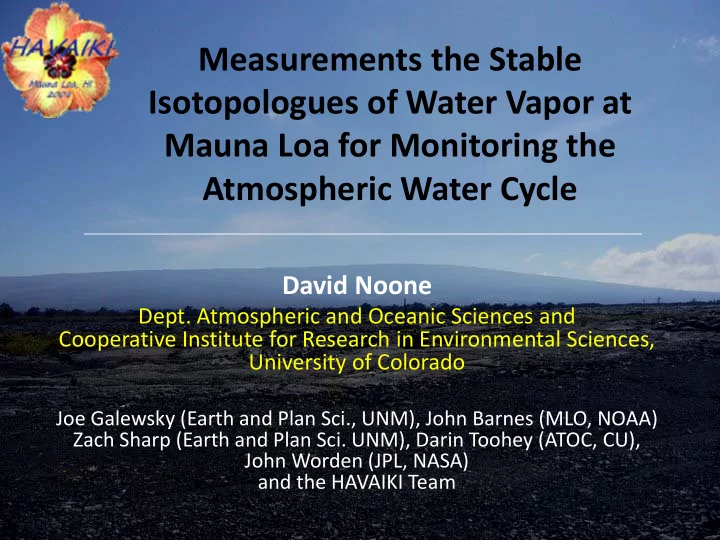

Measurements the Stable Isotopologues of Water Vapor at Mauna Loa for Monitoring the Atmospheric Water Cycle David Noone Dept. Atmospheric and Oceanic Sciences and Cooperative Institute for Research in Environmental Sciences, University of Colorado Joe Galewsky (Earth and Plan Sci., UNM), John Barnes (MLO, NOAA) Zach Sharp (Earth and Plan Sci. UNM), Darin Toohey (ATOC, CU), John Worden (JPL, NASA) and the HAVAIKI Team
Overview • Why isotopes? • Understanding budgets – Isotopes provide additional constraint • Measurements at Mauna Loa – Raw data ( δ D, not 18 O today) – Budget analysis (quick taste) – Sources of water (it’s not evaporation!) • Next steps Noone, D., 2008: An isotopic evaluation of the factors controlling low humidity air in the troposphere. J Climate, in review. Noone and 13 others, 2009: Identification of moistening and dehydration processes in the North Pacific subtropical dry zone from continuous water isotopologue measurements at Mauna Loa, J G R, in prep.
Reminder of isotope physics 18 O O H O H H H Ratio of HDO to H 2 O H D Measured as a difference from ocean water. α R δ = − 1 vapor liquid R (e.g., atmosphere) (e.g., ocean) ocn Two simple isotope models… Condensation Evaporation Vapor becomes depleted as heavy Returns to isotopic composition of removed preferentially the (ocean/land) source. Conditions under which condensation occurs is different from the conditions when evaporation occurs
TES δ D climatology (850 ‐ 500 hPa) December 2004 – March 2008 Brown et al., in prep, Helliker and Noone in press, Noone, et al., in prep., Brown et al., 2008, Worden et al., 2007, Worden 2006
Climate, water cycle feedbacks, water resources Evaluation, statistical reliability Models Satellite data Isotope enabled TES HDO (CAM, GISS, … ~10) also IASI, SCHIAM’Y Water Validation isotopes Spatial context In situ measurements Process studies (Clouds, land surface exchange…) Traditional sampling (IRMS), commercial optical analyzers Only in the last few years have atmospheric (LGR, Picarro) isotope observations surpassed models (TES and now LGR and Picarro)
HAVAIKI 2008 Hawaii Atmospheric Vapor Isotope “Knowledge” Intercomparison PIs: David Noone (U. Colorado) and Joe Galewsky (U. New Mexico) Objectives 1. Test optical analysers JPL, Picarro, Los Gatos Research 2. Provide validation opportunity for TES and IASI HDO 3. Science objectives Understand hydrology of dry zones University of Colorado University of New Mexico Los Gatos Research PI: David Noone PI: Joe Galewsky Feng Dong Adriana Bailey Zach Sharp Doug Baer Derek Brown John Hurley Manish Gupta Darin Toohey Leah Johnson Mel Strong Picarro NASA JPL Eric Crosson Lance Christensen NOAA Mauna Loa Obs Priya Gupta Chris Webster John Barnes Aaron van Pelt John Worden
Cryogenic traps Vacuum flasks http://cires.colorado.edu/ science/features/vapor/ LGR WVIA Picarro IWVA JPL TWI Inlet
Water and isotopes at Mauna Loa General agreement between instruments Some differences in details Dominant diurnal cycle Very dry night (free troposphere) Boundary layer during daytime Noone et al., JGR, in prep,
marine troposphere boundary Notice difference in shape: layer This is where the information from isotopes resides. Enormous! Instruments sensitive < 1 permil
Noone et al., JGR, in prep
Column precipitable water Dry, subtropical nights Moist, “river” outflow
Theoretical guidance: box budgets Mixing/hydration Condensation dq = − [ ] ( ) Ei/E given by Craig and Gordon (1965) ⎛ ⎞ E P ( ) ( ) q R 1 ⎜ ⎟ δ ≈ − = − δ − − − − δ − δ = α − ˆ (Fick’s law) ˆ 1 ln 1 q ( 1 H ) ( 1 H ) ⎜ ⎟ dt 0 ⎝ ⎠ R q q α Pi/P assume fractionation against qi/q s 0 dq ( ) [ α = = − ] e − η i (Rayleigh ‐ like) = − − E P ˆ ˆ H q q q q α − + i i ( 1 f ) f i i , 0 0 dt e Noone, J, Climate, in review
Framework for interpreting HDO (Noone, in review) “6 easy pieces” Very powerful analytic tool since constrains system Two things to worry about: 1) What is source composition? (end members, balance of sources) 2) What is slope ? (rainfall efficiency, type of cloud)
Picarro Los Gatos Daytime Nighttime Measurements immediately confirm theory! Thus theory can be used to interpret data. Key aspect is that it is a 2 dimensional problem, to give a cycle.
The source for diurnal cycle Collapse of the MBL in the evening is simple mixing. Daytime growth has a “third” reservoir: boundary layer clouds Source is identified as evaporation of ocean water near 28 ° C (plus kinetic effects) Similar to a “Keeling plot” used for 13 C/C Mean source, OK. What about sources for individual days/events?
What is the moisture source? (end member for mixing) Day Night Daytime source – evaporation from the ocean (“O”) Nighttime – detrainment from shallow convection (“C1”, “C2”) (importantly, NOT evaporation) Probability distributions only possible with high volume of data (satellite and in situ)
Conclusions HAVAIKI Present generations of in situ analyzers are good for baseline • measurements. They can achieve laboratory precision tied to established calibration • standards in deployment Source of troposphere air is detrainment from convection • (not direct evaporation, as in the boundary layer) Four field week test was a success, we’re ready for longer records • (and science) More generally … Water vapor is the most important greenhouse gas • The water cycle is changing in subtle ways associated with shifts in the • budget terms Meteorological measurements don’t capture the “why” well • Isotopes capture processes (cloud type and source distribution) • Useful to constraining mixing for other species (CO 2, aerosols, …) •
Deep anvils and cirrus cloud freezing eddies Shallow detrainment MLO MBL top
Recommend
More recommend